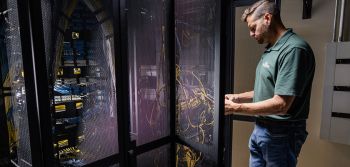Four Reasons You Need a Cybersecurity Plan
- March 17, 2022
- Best Practices
- Automation

Your coworker is working from home. As the workday winds down, he orders dinner online, adds some groceries to his cart and finishes returning emails. One more “urgent” request comes from his “vendor.” He decides to act fast and clicks a link in the email. Unknowingly, he has exposed your whole company to a world of trouble. The Internet makes daily life easier for many of us, but this increase in convenience also leads to an increased risk of cyber-attacks—for individuals and businesses alike.
While it may seem surprising, manufacturing was the most targeted industry for cyber-attacks in 2021 (IBM). The emphasis on digital transformation and the growing importance of networks in industrial automation makes having a plan to identify, protect, detect, respond and recover in the event of a cyber-attack crucial. Here are four fundamental factors for why you need to have a cybersecurity plan
It is Risky
Much like car or health insurance, the reward in investing in cybersecurity is mitigating risks. Downtime due to a cyber incident can result in losses of tens or hundreds of thousands of dollars depending on the size and scope of the company and plant.
Downtime and loss of production are the most obvious risks, but less obvious risks exist too. Paying off a hacker who has installed ransomware in the plant or paying for recovery work after an attack can be costly. There are also risks that are more difficult to quantify. What if a piece of equipment malfunctions and puts one of your employees in danger? How much additional effort will it take to run production manually if you have to shut down your plant network? How will your customers react if their confidential information is stolen as a result of a malicious cyber-attack, and what would it mean to your brand if your recipes were altered and the product you shipped was not what you expected?
It can Happen from Anywhere
Cyber-attacks can originate from inside or outside of a facility. Internally, employees accessing certain websites, clicking a link in a nefarious email or inserting a thumb drive that contains unexpected malware into a PC connected to the network can grant access to network information or execute unintended malicious programs. Externally, hackers try to find gaps in the security system and break in.
Security gaps are especially prevalent in manufacturing facilities because the lifecycle of equipment is typically 15-30 years and tends to go unpatched for years at a time. For comparison, equipment has a typical lifecycle of five years in the IT world with continuous patching as a standard practice. In this age of digital transformation and IIoT, it is more common for businesses to require data from plant devices, which means cloud and enterprise connectivity to the plant floor is a must. That ultimately leads to more vulnerabilities for attackers to exploit.
It is hard to detect
Cyber-attacks are dangerous because they are difficult to detect. It takes an average of 56 days to detect an industrial data breach. By that time, it may be too late to prevent damage from happening.
To detect an attack, you must baseline your assets and typical network traffic and then continuously monitor for abnormalities. A person or team of people cannot possibly monitor and detect hundreds or thousands of assets and associated traffic. That is why technology like Continuous Threat Detection is so important.
It is getting more frequent
In the last three years, there have been over $12 billion in damages due to ransomware attacks, and 53 percent of industrial manufacturers have experienced a cybersecurity breach in their facility (Cybersecurity Ventures research study). Manufacturing facilities are often at higher risk since many connect older systems to enterprise systems or the cloud to collect production data.
Cyber-attacks will only become more prevalent with more workers connecting from home and businesses increasingly relying on converged operations and networks to make more informed production decisions. Unfortunately, cyber risks are here to stay. What steps have you taken to ensure business continuity and stability for your operation?
Let us help you protect your business from cyber threats. For help identifying, detecting, and protecting against cyber-attacks, please reach out to our expert team.

ARTICLE BY:
JACKIE LAFLUER
EMPLOYEE-OWNER, CUSTOMER SEGMENT MANAGER